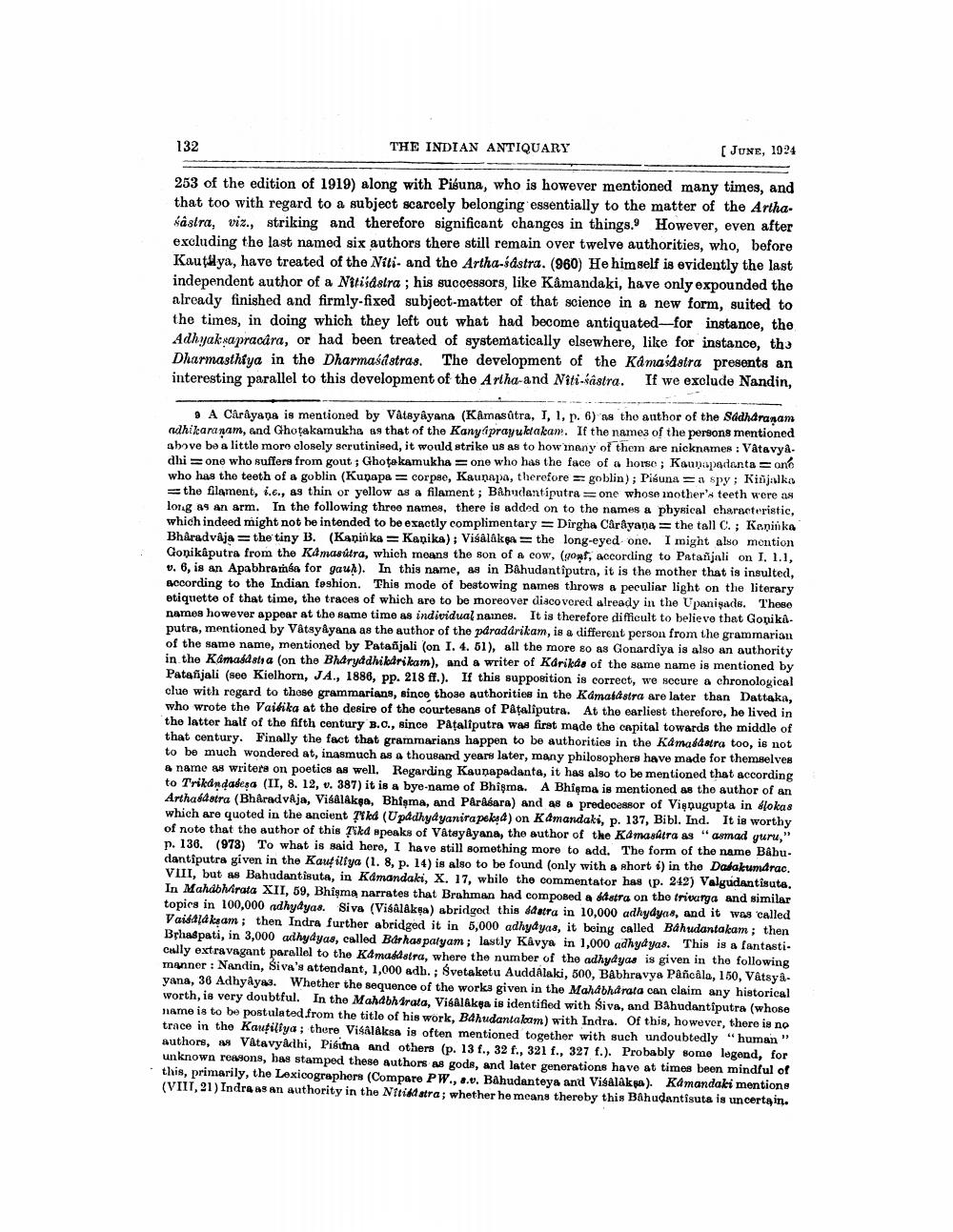________________
132
THE INDIAN ANTIQUARY
[JUNE, 1924
253 of the edition of 1919) along with Pisuna, who is however mentioned many times, and that too with regard to a subject scarcely belonging essentially to the matter of the Arthakastra, viz., striking and therefore significant changes in things. However, even after excluding the last named six authors there still remain over twelve authorities, who, before Kautilya, have treated of the Niti- and the Artha-sastra. (960) He himself is evidently the last independent author of a Nitidslra ; his successors, like Kamandaki, have only expounded the already finished and firmly-fixed subject matter of that science in a new form, suited to the times, in doing which they left out what had become antiquated-for instance, the Adhyak na pracára, or had been treated of systematically elsewhere, like for instance, thu Dharmasthiya in the Dharmasastras. The development of the Kamasdatra presents an interesting parallel to this development of the Artha and Niti-sastra. If we exclude Nandin,
O A Carayana is mentioned by Vatay Ayana (Kámasútra, I, 1, p. 6) tho author of the Sadharanam adhilaranam, and Ghotakamukha as that of the Kanysprayulakan. If the names of the persons mentioned above be a little more closely serutinised, it would strike us as to how many of them are nicknames : Vâtevyadhi = one who suffers from gout; Ghotakamukha = one who has the face of a horso; Kaunapadenta = ono who has the teeth of a goblin (Kupapa = corpse, Kaunapa, therefore = goblin); Pilluns a Py: Kinjalka
the filament, i.e., as thin or yellow as a filament; Båhudantiputra=one whose another teeth were as long as an arm. In the following three names, there is addod on to the names a physical characteristic, which indeed might not be intended to be exactly complimentary Dirgha Carayana = the tall C.; Keninka Bharadvaja = the tiny B. (Kaninka = Kanika): Višalákss the long-eyed one. I might also mention Conikäputra from the Kamasutra, which means the son of a cow, (gouf, according to Patañjali on I. 1.1, v. 6, is an Apabhramba for gauh). In this name, as in Bahudantiputra, it is the mother that is insulted, according to the Indian feshion. This mode of bestowing names throws a peculiar light on the literary etiquette of that time, the traces of which are to be moreover discovered already in the Upanigads. These names however appear at the same time as individual naines. It is therefore difficult to believe that Gonikaputra, mentioned by Vatay Ayana as the author of the pdraddrikam, is a different person from the grammarian of the same name, mentioned by Patañjali (on I. 4. 51), all the more 80 as Gonardiya is also an authority in the Kamasastra (on the Bharyddhikarikam), and a writer of Kdrikda of the same name is mentioned by Patañjali (sco Kielhorn, JA, 1886, pp. 218 ff.). If this supposition is correct, we secure a chronological clue with regard to those grammarians, since those authorities in the Kamasastra are later than Dattaka, who wrote the Vaidika at the desire of the courtesans of Pataliputra. At the earliest therefore, he lived in the latter half of the fifth century B.C., since Pataliputra was first made the capital towards the middle of that century. Finally the fact that grammarians happen to be authorities in the Kamasdatra too, is not to be much wondered at, inasmuch as a thousand years later, many philosophers have made for themselves & name as writera on poetics as well. Regarding Kaunapadanta, it has also to be mentioned that according to Trikdy dadesa (II, 8. 12, v. 387) it is a bye name of Bhima. A Bhişma is mentioned as the author of an Arthaldatra (BharadvAja, VisAlAksa, Bhisma, and Párásara) and as a predecessor of Vinnugupta in blokas which are quoted in the ancient ?' kd (Upddhyd yanira peks) on Kamandaki, p. 137, Bibl. Ind. It is worthy of note that the author of this fikd speaks of Vatay Ayana, the author of the Kamasutra as "asmad yuru," p. 136. (973) To what is said here, I have still something more to add. The form of the name Bahu. dantiputra given in the Kaufiltya (1. 8, p. 14) is also to be found (only with a short i) in the Dalakumdrac. VIII, but as Bahudantisuta, in Kamandaki, X. 17, while the commentator has ip. 242) Valgudantisuta. In MahdbMirata XII, 59, Bhisma narrates that Brahman had composed a flatra on the trivarga and similar topics in 100,000 ndhydyas. Siva (Visalaka) abridged this ddatra in 10,000 adhydyas, and it was called Vaidaja knam; then Indra further abridged it in 5,000 adhyd yas, it being called Båhudantakam; then Brhaspati, in 3,000 adhydyas, called Bdr has palyam; lastly Kavya in 1,000 adhyd yas. This is a fantasti. cally extravagant parallel to the Kamaldatra, where the number of the adhyd yas is given in the following manner: Nandin, Siva's attendant, 1,000 adh.; Svetaketu AuddAlaki, 500, Babhravya Pancala, 150, Vâtsyayana, 36 Adhyâyas. Whether the sequence of the works given in the Mahabharata can claim any historical worth, is very doubtful. In the Mahabharata, VibAlekça is identified with Siva, and Bahudantiputra (whose name is to be postulated from the title of his work, BAhudantakam) with Indra. Of this, however, there is no trace in the Kanfiliya; there Visalaksa is often mentioned together with such undoubtedly "human" authors, Vatavyathi, Pibita and others (p. 13 f., 32 f., 321 1., 327 f.). Probably somo legend, for unknown reasons, has stamped these authors as gods, and later generations have at times been mindful of this, primarily, the Lexicographers (Compare PW., ... Bahudanteya and Visalaksa). Kamandaki mentione (VIIT,21) Indra as an authority in the Nftillatra; whether he means thereby this Bahudantisuta is uncertain.




